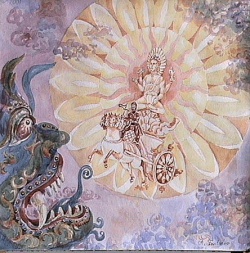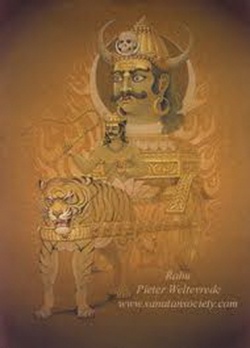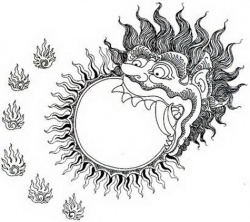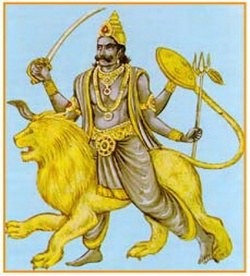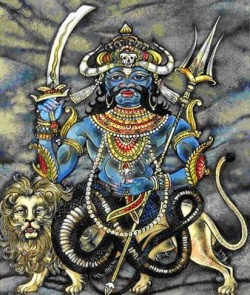Rahu
In Hindu tradition, Rahu is a cut-off head of an Asura, that swallows the sun causing eclipses. He is depicted in Art as a serpent with no Body riding a chariot drawn by eight black horses. Rahu is one of the navagrahas (nine planets) in Vedic Astrology. The Rahu kala (time of day under the influence of Rahu) is considered inauspicious.
According to legend, during the Samudra manthan, the Asura Rahu drank some of the amrita (divine nectar). Sun and moon realized it and they alerted Mohini (the female avatar of Vishnu). Before the nectar could pass his throat, Mohini cut off his head. The head, however, remained immortal due to the effect of amrita and became Rahu. It is believed that this immortal head from time to time swallows the sun, causing eclipses. Then, the sun passes through the opening at the neck, ending the eclipse. The Body also turned into Ketu due to a boon, and it in turn swallows the moon on timely basis to cause a lunar eclipse.
Astronomically, the Moon in its orbit, on a northerly course from South to North, crosses the ecliptic (the apparent path of Sun). This point of intersection is known as Rahu or "Dragon's head". 180 degrees away from this point, the Moon on its southerly course crosses the ecliptic. This point is called "the dragon’s tail" or Ketu.
Thus, Ketu and Rahu denote the points of intersection of the paths of the Sun and the Moon as they move around the celestial sphere. Therefore, Rahu and Ketu are respectively called the north and the south lunar nodes. The fact that eclipses occur when the Sun and the Moon are at one of these points is explained in stories as the swallowing of the Sun and the Moon by the demon snake.
Thus, Rahu and Ketu do not have physical identity but only mathematically calculated sensitive points. The Rahu and Ketu points are not stationary in space but have a mean motion of about 19 degrees and 30 minutes in a year. It means it takes about 18 years and 6 months to make a revolution around the Earth. This motion is retrograde. There is a concept of Mean Rahu and True Rahu. The ancient Hindu Astrology takes the true position of Rahu and Ketu. It is unique in the sense that it was the first to have a dedicated name for these identified astronomical points that are helpful in deducing eclipses.
Rahu is a legendary master of deception who signifies cheaters, pleasure seekers, operators in foreign lands, drug dealers, poison dealers, insincere & immoral acts, etc. It is the significator of an irreligious person, an outcast, harsh speech, falsehoods, uncleanliness, abdominal ulcers, bones, and transmigration. Rahu is instrumental in strengthening one's Power and converting even an enemy into a friend. In Buddhism Rahu is one of the krodhadevatas (lit: Anger divinities. i.e., a divinity having the attributes of Anger and the like).
In ancient Tamil astrological scripts, Rahu was considered as incarnation of Shakthi (The female godess) and deitized as "Kali", "Bhadrakali". During the War, Shakthi (The female godess) defeated the Evil forces and took an agressive Form which was worshipped as "Kali" and her beasty state as "Rahu". It was considered, very hard to please "Rahu", but contrarily "Rahu" blesses with Great Boons and Good fortunes on her own. Great Scholar Mahakavi Kalidas was blessed by the Godess Kali (The deity Form of Rahu) who became a great scholar and gave textual forms for Vedas and wrote current day literatures. Great Scholar Tenali Ram, in Vijay nagar kingdom of late 14th centuries was another example. In general, people with aspects from "Rahu" will have soft corner for destitute women and tend to get easy support from women folks. Also "Rahu" had a great passion with Lord Shiva (The deity Form of Sun) and their union lead to the offspring, which was Saturn.
In Vedic Astrology Rahu is seen as an Asura or demon who does his best to plunge any area of Life he controls into chaos, mystery, and cruelty. He is associated with the World of material manifestation and worldly desire, as well as random, uncontrolled growth without Wisdom or understanding.
Rahu is supposed to be a mighty and naughty child of Maya, and thus has a lot of dualities attached to its mayavi (illusory) nature. It relates to the Seventh Ray energy of esoteric Astrology, as it represents a force displaying all the possibilities within the realm of existence.
Various names assigned to Rahu in Vedic texts—the chief, the advisor of the demons, the minister of the demons, ever-angry, the tormentor, bitter enemy of the luminaries, Lord of illusions, one who frightens the Sun, the one who makes the Moon lustreless, the peacemaker, the immortal (having drunk the divine nectar), bestower of prosperity and Wealth and ultimate Knowledge—give a clue to its basic energy and attributes.
Rahu can be considered the expert among the planets when it comes to scheming and plotting. It is the master of manipulation.
The astrological text Lal Kitab makes an interesting point that if Jupiter and Venus are conjunct in a chart, they can together be treated as Rahu. This relates to the fact that Rahu acts as a bridge between Jupiter, the preceptor of the gods, and Venus, the preceptor of the demons.
Mining of petroleum also falls under the significations of Rahu according to Vedic Astrology. Snake charmers and all other people whose lives are very much entwined with that of reptiles and snakes could be said to be under a heavy influence of Rahu.
Rahu governs all sorts of poisonous chemicals like fertilizers, pesticides, and disinfectants that are in use in the present times. It also governs all the substances with a strong pungent smell like sulfur dioxide gas. In other words, Rahu has a role to play whenever a poisonous substance is involved.
There is no equal to Rahu when it comes to giving upliftment in name and Fame or sudden luck at Gambling, which is probably the reason why Western astrologers regard it as the greatest benefic force.[original research?] The area in which this success is attained usually relates to the significations of the house Rahu is placed in. All the electric lights that illuminate our World in the nighttime can be said to be associated with Rahu. Rahu is known as the "artificial sun," which is fitting considering the introduction of electric lights, adding to the Illusion and glamour of modern times. Rahu has in a way created its own artificial sun for its favoured time, the night.
Rahu's rulership, exaltation, debilitation, and mulatriko?a are topics of controversy, as many views abound as to the sign that Rahu rules. The Western system refuses to assign Rahu the rulership of any sign. In Vedic Astrology, different systems assign Rahu different signs regarding rulership, exaltation, and debilitation. In establishing the rulership, exaltation, and debilitation signs of Rahu, its relationship with other planets may be considered: Rahu is friends with Ketu, Saturn, Mercury and Venus. It is the enemy of Sun, Moon, Mars, and Jupiter. It is important to note that Rahu is more inimical to the Sun as compared to the Moon.
Rahu is Lord of three nakshatras or lunar mansions: Ardra, Svati and Shatabhisha. Rahu is associated with the following: its color is smoky, metal is lead, and its gemstone is Honey-colored hessonite. Its element is air and its direction is southwest. Worship of Rahu
There is a dedicated temple to Rahu - Naganatha Temple at Thirunageswaram, Tamil Nadu, India. There is a milk abhishekam everyday during Rahu Kaalam to appease Rahu. The milk turns Light blue when it flows down after touching the statue of Rahu. This practice has been followed for over 1,500 years.
Rahu is also worshipped along with the other 9 planets in all Hindu temples in Burma. The navagraha deities, featuring nine planets, exist in the Ganesh Temple in Mandalay, Myanmar, and also in the courtyard of the South Indian temple in Silom, Thailand. One complex of this nature, featuring statues of all nine planets, also exists in the Bhairav Mahadev Sthan in Gyaneswor, Kathmandu, Nepal. Phra Rahu, as he is called in Thailand, is worshipped in Wat Traimet in Chinatown, Bangkok, and also in Wat Yannawa, amongst other wats.
In Thailand, the most famous temple for Phra Rahu worshipping is at Nakon Pathom province, a temple called Wat Sisathong.
Rahu is also worshiped by Dusadh (Paswan) Caste found in Bihar. A very hard prayer of three days without Food is offered by devotees. The bhagat (Priest) help him in prayer by standing on ladder made up of sword and by Fire-Offering at which the bhagat walks through the Fire. The ritual is being clearly a device to secure abundance of sunlight and prosperity by the community. Remedies
Ants are also one of the favoured species of Rahu. In some parts of India feeding ants is considered one of the ways of propitiating Rahu.
In Thailand, people offer a plate of black Offering—black coffee, black Coke, black beans, black biscuits amongst other items to propitiate Phra Rahu, whom they hold in very high regard. There is a shrine for Phra Rahu in Wat Traimet near Chinatown in Bangkok.
The other Phra Rahu statue is in the Wat Yannawa, near the Saphan Taksin sky train station. A glass fish-bowl filled with white sugar balls on which ants are fed continuously is also kept in Thai businesses.
In Burma, there are shrines of the nine planets in most Hindu temples, and Puja ceremonies to propitiate all nine planets occur regularly on holy days. Rahu dan in remedial Astrology
Articles for donation: mustard, radishes, blankets, sesame, lead, saffron, satnaja (a mixture of seven grains), and coal. The time to donate is Sunday morning. These articles are to be donated by a person facing the Evil effects of Rahu, or if Rahu is not in a good position in one's horoscope. Rahu Mantra
"Om Bhram Bhreem Bhroum Sah Rahave Namah", 18000 times in 40 days.
"Om Rang Rahuve Namah Om", repeat 270 times for 40 days to get paranormal powers. Hanuman and Rahu
Hanuman, in his childhood, flew towards the sun, as it appeared to be a big fruit. The day was solar eclipse day, when Rahu was to swallow up the sun. Rahu arrived and saw Hanuman also approaching and Thought that Hanuman is trying to swallow the sun; little Hanuman, seeing Rahu, was attracted to the curiosity of the disembodied head, and caught Rahu.
On another occasion, during the Ramayana War, Ravana imprisoned the Navagrahas. Hanuman arrived and released them. They were grateful to Hanuman, saying "people devoted to you are blessed by us too." All the grahas thanked Hanuman individually for releasing them. Thus, it is believed that Rahu's negative influence will be subdued when one worships Lord Hanuman. Buddhism
Rahu is mentioned explicitly in a pair of scriptures from the Samyutta Nikaya of the Pali Canon. In the Candima Sutta and the Suriya Sutta, Rahu attacks Chandra the moon deity and Suriya the sun deity before being compelled to release them by their recitation of a brief stanza conveying their reverence for The Buddha. The Buddha responds by enjoining Rahu to release them, which Rahu does rather than have his "head split into seven pieces". The verses recited by the two celestial deities and The Buddha have since been incorporated into Buddhist liturgy as protective verses (paritta) recited by Monks as prayers of protection.
In the Tibetan Buddhist tradition, Rahu (or Rahula; Tib. gza) is considered to have been subjugated by Padmasambhava, becoming one of the principle Protectors of the Dzogchen teachings, particularly the Longchen Nyingthik. He is usually depicted with nine heads and a thousand eyes all over his dark-colored Body. In his four arms he holds a bow and arrow, and often a lasso and victory banner. He is wrathful in appearance, ablaze with Fire, and his lower Body has the Form of a snake. Rahula is a sa, a class of deities associated with the heavenly bodies.
